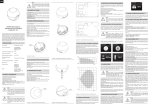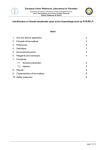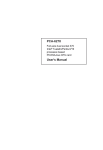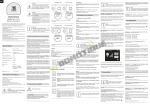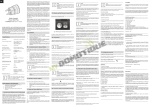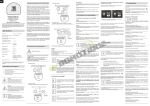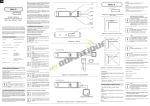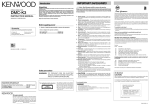Download Fibaro FGSS-101 smoke detector
Transcript
ENG ! Power Supply: 12 - 24 VDC Battery Type: CR123A Power Consumption (at VDC operation): 0,4W Output terminals maximum current carrying capacity (SMOKE NC, TAMP NC): 25mA Maximum voltage at output terminals (SMOKE NC, TAMP NC): 24V (AC or DC) EU standards compliance: EMC 2004/108/EC R&TTE 199/5/WE Radio protocol: Z - Wave Radio frequency: 868,4 MHz EU; 908,4 MHz US; 921,4 MHz ANZ; 869,2 MHz RU; Range: up to 50m outdoors up to 30m indoors (depending on terrain and building structure) Operational Temperature: 0 - 40oC Measured Temperature Range: -20 to 100oC Temperature Measuring Accuracy: 0,5oC (within 0oC - 40oC range) Dimensions (Diameter x Height): 65 x 28 mm TECHNICAL INFORMATION • Compatible with any Z-Wave Controller. • May be connected to any alarm or fire prevention system by hard wiring NC output • Extremely easy installation - simply install it in location prone to fire. • Battery or VDC powered. • Built-in tamper switch. • Alarm is signaled by sound and LED diode. • Fire detection through air temperature measuring. • Can trigger alarm just by exceeding temperature threshold. • 3 levels of sensors sensitivity. • Automatic efficiency test performed every 5 seconds. • Built-in “black box” allows the device to report and record smoke and temperature readouts. ! NOTE Depending on the Smoke Sensors internal conditions (e.g. battery discharge, device failure, etc.) and installation conditions, this device may not be 100% accurate. This device can significanlty increase the probability of fire detection. Smoke Sensors must be tested regularly according to this operating manual and local code. Ventilation systems, chimneys and potentially dangerous devices that can cause a fire should be regularly inspected as well. I. Z-WAVE NETWORK INCLUSION There are two ways to include a Fibaro Smoke Sensor into the Z-Wave network: 1) Automatically, using the auto inclusion function (available in constant current powering mode), or 2) Manually - using the B-button (option available in both powering modes hard wired or battery powered). Including a Fibaro Smoke Sensor into the Z-Wave network in auto inclusion mode: 1) Make sure the Fibaro Smoke Sensor’s power is disconnected and/or the battery is removed prior to auto inclusion and located within the direct range of Z-Wave controller. 2) Set the main controller into the learning mode (see main controller’s operating manual). 3) Connect the power to the sensor to include it into the Z-Wave network. 4) Fibaro Smoke Sensor will be detected and included into the Z-Wave network. i NOTE In case the device is not detected, include it manually (as described below) or reset the sensor and repeat the procedure above. B - button and LED indicator INSTALLATION NOTES: 1) When choosing location of smoke sensor, make sure the alarm sound can be easily audible in other rooms in the building. 2) It’s recommended to install the sensor in already decorated, painted rooms. 3) It’s recommended to install the sensor at least 1,5m from air conditioners. 4) Do not install the sensor in insolated places. Keep at least 0,5m distance from light sources. 5) Do not install the sensor in places prone to draughts. 6) Do not install the sensor in places with high water vapor condensation, e.g. above stoves, ovens, kettles, etc. IV. POWERING MODES There are two powering modes for the Fibaro Smoke Sensor. By default it’s powered by a factory included battery. Alternatively it can work with a constant current, after connecting a 12 / 24 VDC power source to +12/24 and GND terminals (see diagram #3). Powering mode configuration is carried out automatically, while sensor is being included into the Z-Wave network. When battery powered, a Fibaro Smoke Sensor communicates with the Z-Wave network main controller periodically. Smoke detection is sent immediately. Configuration parameters and association settings are sent periodically at specified wake up intervals, or at a manual wake up (triple click B-button). In DC powering mode, configuration and association parameters are sent when necessary, and additionally the smoke sensor serves as a Z-Wave signal repeater. Switching to a constant current powering mode: 1) Exclude a sensor from the Z-Wave network. 2) Disconnect the battery, 3) Install the constant power connecting terminal, observing the diagram #3. 4) Connect the constant current power to the power terminal (12 / 24 VDC) to +12 and GND terminals observing wiring diagram #3. 5) Include Fibaro Smoke Sensor into the Z-Wave network. ! i ! When included in the Z-Wave network, Fibaro Smoke Sensor tests the network communication. The Z-Wave network communication test is performed in both hard wired and battery powering modes during every temperature report. By default, once the ambient temperature changes by 2ºC, according to parameters 10 and 12 settings. In addition, in battery mode, the Z-Wave network communication test is performed at device polling. In constant power mode, the Z-Wave network communication test is performed in time intervals defined by parameter 80 settings. Lack of the Z-Wave network communication is signaled by an intermittent alarm sound and LED blinking pink. Fig. 2 - Constant current or alarm system hub connecting terminals installation. II. EXCLUDING FIBARO SMOKE SENSOR FROM THE Z-WAVE NETWORK 1) Make sure the sensor is connected to power source (battery and/or hard wired). 2) Set the main controller into the learn mode (see main controller’s operating manual) 3) Quickly, triple click the B-button, located on Fibaro Smoke Sensor’s enclosure. III. SENSOR INSTALLATION TMP i NOTE It’s recommended to install the sensor on the ceiling or upper portion of wall at least 40 cm (2 feet) from corners and other objects. Particular attention should be paid to any adjacent objects or devices which can impede smoke’s access to the sensor. It’s recommended to install Fibaro Smoke Sensor in all rooms prone to fire, and in between such rooms as well. ! 1) Include the device into the Z-Wave network (see p.I). Note the inclusion process may be performed ONLY in direct range of the main controller. 2) If the sensor is hard wired to power source, drill holes in sensor’s cover. Note the sensor may be connected to a wired alarm system controller or fire prevention system. 3) Install the sensor’s cover in desired location. 4) If the sensor is to be VDC powered, connect wires observing diagram # 3. If the sensor is to be connected to an alarm system or fire prevention system, connect it observing the diagram # 4. Apart from detecting smoke presence, Fibaro Smoke Sensor can detect fire by recording a rapid temperature rise. Temperature alarm threshold is user defined (parameter 81). Temperature alarm is signaled by the blinking red LED signaling diode blinking red and an intermittent sound signal. NOTE Parameter 81 value is set to 54ºC by default. Any modification of this parameter may cause the Fibaro Smoke Sensor not to work within the valid safety regulations of your country. IX. SENSOR’S SENSITIVITY LEVEL CONFIGURATION ! GND + 12/24 VDC ADAPTER Diagram 1 - DC Power adapter connection. TMP NOTE Fibaro Smoke Sensor is a multiple use device, however, for greater safety, it’s recommended to replace the device with a new one after a fire occurance. VI. DETECTING FIRE THROUGH TEMPERATURE ALARM ! SMOKE TAMP NC NC NOTE As described in section V, the Fibaro Smoke Sensor checks for smoke presence every 5 seconds. In addition, the device checks for damage and tests the Z-Wave network communication at each wake up interval (see section VIII). Installing Fibaro Smoke Sensor NOTE It’s not recommended to deactivate the Z-Wave network communication test. There are 3 sensitivity levels of the optical smoke detector used in Fibaro Smoke Sensor. By default, the detector is set to the middle sensitivity level. Sensitivity level depends on the parameter 82 settings. V. SMOKE DETECTION i Once a Fibaro Smoke Sensor has reported no Z-Wave network communication, it’s recommended to wake up the device by triple clicking the B-button. If it doesn’t stop the alarm, Z-Wave networks operation and the main controllers operation need to be verified. The Fibaro Smoke Sensor will cancel the Z-Wave network communication alarm once it communicates with the network after manual or automatic wake up. ! NOTE 1. It’s not possible to power the device from a battery and VDC power source simultaneously. When using a VDC power souce it’s recommended to use another kind of power back up. 2. Home Center 2 checks the battery level once a day. Fibaro Smoke Sensor responds to the physical presence of smoke. Smoke presence is required for the device to react. Fibaro Smoke Sensor performs a self test every 5 seconds (see section VII) and checks for smoke presence. When smoke is detected, the sensor checks 3 more times, at 1 second interval to see, whether the smoke is actually present. Once the smoke presence is confirmed, Fibaro Smoke Sensor triggers an alarm. Smoke alarm is signaled by sending an appropriate alarm frame to devices and the Z-Wave controller, opening NC contact, and also by a constant sound signal and LED diode blinking red. Once the smoke alarm has ceased, the sensor checks 3 times, at 1 second interval, whether the smoke has actually disappeared before getting back to normal operation, i.e. performing a self test each 5 seconds and checking for presence of smoke. NOTE Any service or repair must be carried out by the manufacturer. VIII. DETECTING LACK OF Z-WAVE RANGE In order to turn off the auto inclusion function, press the B-button once after the power source has been connected to the Fibaro Smoke Sensor. Manual Fibaro Smoke Sensor inclusion: 1) Connect the power source to the Fibaro Smoke Detctor and/or install the battery. Make sure the device is located within direct range of the Z-Wave controller. 2) Set the main controller into the learn mode (see main controller’s operating manual). 3) Quickly, triple click the B-button, located on Fibaro Smoke Sensor’s enclosure. 4) Fibaro Smoke Sensor will be detected and included in the Z-Wave network. NOTE When the self test is triggered manually, the Fibaro Smoke Sensor sends the command frame to the Z-Wave network controller and to the 1st Association group devices. After 3 seconds from releasing the B-button, the alarm cancelling command frame will be sent and the procedure will be finished. Drill holes here BATTERY TIPS Fibaro Smoke Sensor’s battery life is approximately 3 years when on optimum settings. The current battery level is displayed in the Home Center 2 interface. Red battery icon means that battery needs replacement. In order to avoid triggering tamper alarm while replacing the battery, 2-nd association group’s associations must be deleted, and Sensor’s parameters’ configuration set to default. In addition, the device itself, apart from the main controller, monitors the battery level and a low battery is signaled with a yellow blinking LED and an intermittent sound alarm (interval set in parameter 87). The Fibaro Smoke Sensor can signal a low battery level for approximately 30 days. The Fibaro Smoke Sensor can automatically detect a malfunction. As described in section V, the Fibaro Smoke Sensor performs a self test every 5 seconds. If a malfunction is detected (e.g. damaged smoke chamber) an intermittent sound alarm will start, LED diode will blink red and alarm will be sent to the Z-Wave network controller and associated devices. Once a malfunction has been detected, it’s recommended to: • check the power source (replace battery or check VDC adapter’s voltage), • check whether the Smoke Sensor is exposed to direct light. If a malfunction is continually reported, it’s recommended to replace a the Fibaro Smoke Sensor with new one. Self test may be triggered manually: 1) Make sure the device is being powered. 2) Press and hold the B-button untill the LED glows white and short alarm sounds. 3) Keep holding the B-button for an additional 3 seconds from the first beep to check the smoke chamber operation. LED indicator colour changing to green and beep mean the positive result. If the LED indicator changes its colour to red, the sensor is malfunctioning. ! Fig. 1 - Fibaro Smoke Sensor top view. GND SPECIFICATIONS ! NOTE When handled carelessly or used in non-specified environment conditions, the device may not function properly. It’s highly recommended to take all safety precautions to ensure safety and property protection. VII. MALFUNCTION DETECTION +12V - constant power supply terminal, 12/24VDC -GND - ground terminal SMOKE NC - potential free, smoke sensor connecting terminals (for wired systems) TAMP NC - potential free, tamper connecting terminals (for wired systems). +12/24 * Depending on the parameters settings. ! NOTE Maintenance inspections should be perfomed regularly, by a trained staff member. Fibar Group Sp. z o.o. recommends the functional and visual checks to be performed at least once a month. Functional check, includes self test (described below) and triggering smoke detection. DIAGRAMS DESCRIPTION: GND The Fibaro Smoke Sensor is a universal, optical Z-Wave smoke sensor. The device can be hard wired (12 or 24 VDC) or battery operated (battery life 3 years*). Smoke detection is signaled through siren and LED diode blinking. Additionally, the smoke sensor signal can be sent to an alarm system or fire alarm system hub, through a NC (normally closed) contact terminals. The optical sensor detects smoke at an early stage of fire, often before flames appear and temperature starts to rise significantly. Moreover the device has a built-in temperature sensor, which can also trigger the alarm once the specified temperatute threshold is exceeded. The Fibaro Smoke Sensor is designed to be placed on a wall or ceiling. LED indicator signals fire, operating mode and used to see if device is within the Z-Wave network. The smoke sensor is designed to operate in confined spaces, under normal conditions (lacking smoke, dust, condensed water vapor). ! NOTE Work within local code height requirements for installation of the Fibaro Smoke Sensor. Take special precautions during installation and use tools and equipment in perfect working order. It’s recommended to observe ladders, lifts and other obstacles. 5) Screw the Fibaro Smoke Sensor into the cover. 6) If the sensor is already included in the Z-Wave network, wake it up by triple clicking the B-button.. 7) Test Fibaro Smoke Sensor’s operation by using a dedicated optical smoke sensor diagnostic tool. 8) Test the Z-Wave network assuring the device is within range. +12/24 OPERATING MANUAL SMOKE SENSOR FGSS-001 v2.1 - v2.3 NOTE Read this manual before attempting to install the device. Failure to observe recommendations included in this manual may be dangerous or cause a violation of the law. The manufacturer, Fibar Group Sp. z o.o., will not be held responsible for any loss or damage resulting from not following the instructions of operating manual. SMOKE TAMP NC NC X. RESETTING THE FIBARO SMOKE SENSOR The Fibaro Smoke Sensor reset erases the EPROM memory, including all information on the Z-Wave network and the main controller. Fibaro Smoke Sensor reset procedure: 1) Make sure the device has the power connected. 2) Press and hold the B-button for 3 seconds. LED will glow white. 3) Short signal will sound. 4) Release the B-button. 5) Wait until the LED glows yellow, signaling entering the 4th menu level. 6) Press the B-button briefly to confirm menu level choice. Successful reset will be confirmed with the LED changing colour to red and fading. At the same time, short beep will sound, same as at the power connection. ! ALARM SYTEM HUB AUX COM Z1 Z2 NOTE It’s not recommended to change Fibaro Smoke Sensor’s sensitivity level. NOTE Device reset will not remove it from the Z-Wave network main controller’s memory. Before resetting the device, it must be excluded from the Z-Wave network. XI. OPERATING THROUGH THE Z-WAVE NETWORK Fibaro Smoke Sensor has a built in smoke detector and a temperature sensor, which makes it a multi channel device. In the Home Center 2 menu it will be presented as two devices, depending on the main controller software version*: Diagram 2 - Alarm system hub connection. 3) Short signal will sound. 4) Release the B-button. 5) Wait untill the LED glows pink, and then press the B-button briefly to start the test. 6) LED will indicate the Z-Wave network’s range (range signaling modes described below). 7) To exit Z-Wave range test, press the B-button brefly. Fig. 3 Smoke Sensor icon in Home Center 2* Fig. 4 Smoke Sensor icon in Home Center 2 indicating the smoke alarm and a tamper alarm* XII. ASSOCIATIONS Through an association Fibaro Smoke Sensor may control another Z-Wave network device, e.g. a Dimmer, Relay Switch, Roller Shutter, RGBW Controller, Wall Plug, or a scene (scene only through the Home Center 2 main controller) ! NOTE Association allows for direct communication between Z-Wave network devices. Main controller does not take part in such communication. Using this mechanism, Fibaro Smoke Sensor may communicate with other devices even when the main controller is damaged, e.g. in a fire. Fibaro Smoke Sensor allows for the associations of three groups. 1-st Association Group is assigned to the device status - sending the BASIC SET (default) or ALARM control frame to the associated devices having detected fire. The type of alarm frame sent may be modified in advanced configuration parameters (see section XVII). 2-nd Association Group is assigned to the TMP button and the malfunction alarm. Alarm frame will be sent to the associated devices once tampering or malfunction are detected. 3-rd Association Group reports the device status and allows for assigning a single device only (the main controller by default - the device reports its status to the main controller). It’s not recommended to modify this association group. Fibaro Smoke Sensor allows for controlling 5 regular and 5 multichannel devices per an association group, out of which 1 field is reserved for the Z-Wave network main controller. To add an association (using Home Center 2 interface) go to device settings and click the following icon: Select the “device options” tab. Then specify to which group and what devices are to be associated. Sending relevant information to devices that have been added to association group may take up to a few hours depending on the previous configuration parameters’ settings. Z-Wave range tester signaling modes: LED indicator pulsing green - Fibaro Smoke Sensor attempts to extablish a direct communication with the main controller. If a direct communication attempt fails, sensor will try to establish a routed communication, through other modules, which will be signaled by LED indicator pulsing yellow. LED indicator glowing green - Fibaro Smoke Sensor communicates with the main controller directly. LED indicator pulsing yellow - Fibaro Smoke Sensor tries to establish a routed communication with the main controller through other modules. LED indicator glowing yellow - Fibaro Smoke Sensor communicates with the main controller through the other modules. After 2 seconds the sensor will retry to establish a direct communication with the main controller, which will be signaled with LED blinking in green. LED indicator pulsing violet - Fibaro Smoke Sensor communicates at the range limit. If connection proves successful it will be confirmed with a yellow glow. It’s not recommended to use the sensor at the range limit. LED indicator glowing red - Fibaro Smoke Sensor is not able to connect to the main controller directly or through another Z-Wave network nodes. ! NOTE During the Z-Wave network range test and during the software update as well, Fibaro Smoke Sensor does not detect smoke presence. Once the Z-Wave network range test and software update is completed, the device resumes normal operation. XVI. BLACK BOX The Fibaro Smoke Sensor has a built in memory for recording smoke and temperature information. Having recorded even the smallest amount of smoke, the sensor records the smoke level measured, time and temperature measured at that precise moment. This information is sent to the Z-Wave network main controller every 60 seconds. Home Center 2 allows for monitoring Black Box recordings (see below figure). The Fibaro Smoke Sensor stops sending the Black Box records once the smoke disappears, but a user can always access earlier reports through the Z-Wave main controller. Black Box sensitivity may be modified through the parameter 83 settings. ! NOTE Black Box gathers and sends the information even when there’s no fire alarm. XIII. LED VISUAL INDICATORS AND SETTINGS The Fibaro Smoke Sensor is equipped with a LED diode for indicating, signaling sensor’s operating modes and alarms. In addition the LED indicator may inform of the Z-Wave network range and the current temperature. To enter MENU, press and hold the B-button for 3 seconds. Once the LED glows white, release the B-button. LED will then start changing colours in sequence. Each colour means different MENU level. Press the B-button briefly to confirm choice. Transitions between the MENU levels will be signaled with a short beep as well. ! NOTE During the Z-Wave network range test, Fibaro Smoke Sensor is not detecting smoke presence. Device resumes normal operation once the Z-Wave network range rest has been finished. XIV. CANCEL ALARM FOR ASSOCIATED DEVICES The Fibaro Smoke Sensor automatically cancels smoke alarms sent to the Z-Wave network controller and the associated devices. It’s possible to delay or deactivate the alarm cancellation by modifying parameter 1 settings. In such a case, once an alarm is detected, it will be constantly reported unless manually cancelled by choosing green MENU level. ! NOTE Tamper alarms cannot be cacelled through MENU. XV. Z-WAVE RANGE TEST The Fibaro Smoke Sensor has a built in Z-Wave network main controller’s range tester. Follow the below instructions to test the main controller’s range: 1) Make sure the sensor is powered. 2) Press and hold the B-button for 3 seconds. LED will glow white. ! NOTE Parameter settings do not influence the visual and acoustic alarms, which are turned off once the smoke has disappeared. 2. LED indicator and acoustic alarm turned ON / OFF at any alarm type. Allows for deactivating the LED indicator and the acoustic alarm, in case of detecting an alarm of any type. This doesn’t affect the communication with the Z-Wave network controller, i.e. the sensor will keep sending alarms, reports and all information to the associated devices. Modifying this parameter settings helps extending the battery life. Available settings: 0-3 0 – acoustic and visual alarms inactive 1 – acoustic alarm inactive, visual alarm active 2 – acoustic alarm active, visual alarm inactive 3 – acoustic and visual alarms active Default setting: 3 Parameter size: 1 [byte] ! NOTE Deactivating the acoustic and visual alarms may result in insufficient reporting of the smoke alarm. It’s not recommended to modify this parameter settings. 5. Type of alarm frame sent to 1-st Association Group devices (smoke alarm). Allows for choosing a command class used in 1-st Association Group. Available settings: 0, 255 0 - ALARM SENSOR (SMOKE) command frame, 255 - BASIC_SET command frame. Default setting: 255 Paramter size: 1 [byte] 7. Forced level of dimming / opening dimmers, roller blinds etc. devices at sending turn on / open / change level commands to 1-st Association Group’s devices. The value of 255 allows for turning on a device. In case of Dimmer, the value of 255 means turning on the device with the last memorized state. E.g. Dimmer set to 30% and then turned off, and next turned on using the 255 command, will turn on with the last remembered status, i.e. 30%. In case of alarm frames, alarm priority is defined. Available settings: (1 - 99) or 255 Default setting: 255 Parameter size: 1 [byte] ! NOTE 2-nd association group alarms cannot be cancelled. 10. Temperature report interval. Time interval between consecutive temperature reports. The parameter is relevant for the battery powering mode only. Longer time interval means less frequent communication and thus a longer battery life. Report is sent when new temperatue value is different from the one previously reported. Temperature reports can be also sent as a result of polling. Available settings: 1 – 17280, 0 (multiply by 5 seconds) [5s-24h] 0 – reports inactive Default setting: 0 (Reports inactive) Parameter size: 2 [bytes] LED indicator signaling modes: 1) Fire alarm is signaled by blinking in red. 2) Tamper alarm is signaled with a short blink in red. 3) Malfunction alarm is signaled by blinking in red. 4) Z-Wave network range alarm is signaled by blinking in pink. 5) Low battery alarm is signaled by blinking in yellow. 6) MENU levels are signaled with glowing in certain colour. LED colours will change in the following sequence: WHITE - entering MENU + self test GREEN - refresh alarm state for the associated devices PINK - Z-Wave communication test. YELLOW - sensor reset. 0 - no delay, immediate cancellation 65535 - alarm cancellation inactive - Smoke Sensor will keep indicating smoke alarm after the smoke will have disappeared. The smoke alarm can be only ceased manually, by entering 2nd menu level (see section XIII). Default setting: 0 Parameter size: 2 [bytes] Fig. 5 Fibaro Smoke Sensor black box chart. i Black Box recordings are stored for about 24 hours, depeding on the parameter 83 settings and working environment conditions. User may force sending these recordings to the Z-Wave network main controller, depending on its model and software version. XVII. ADVANCED CONFIGURATION WAKE UP INTERVAL: (3 bytes) Available settings: 300 - 86399 (5min – 24h) Default setting: 14400 (each 4h) When the Smoke Sensor is in battery power mode you can set up the wake up time based in seconds. At each wake up, a the Smoke Sensor communicates with the main controller, updates parameters settings and the software if necessary. The Smoke Sensor will wake up at defined time interval and will ALWAYS try to communicate with the main controller. After each failed communication attempt, the sensor will retry to establish connection with the main controller after 60 seconds. After 3 failed attempts, the lack of the Z-Wave range alarm will be triggered. The parameter is relevant for the battery powering mode only. Longer time interval means less frequent communication and thus a longer battery life. The Z-Wave range alarm will be cancelled automatically, after first successfull connection. ! NOTE Default value of the Wake Up, in Home Center 2, is 6 hours. 1. Smoke alarm cancellation delay The time between when the smoke disappears and the Fibaro Smoke Sensor stops sending the alarm signal. Available settings: 0 – 17280, 65535 (5s multiplier) [5s-24h] 12. Temperature report hysteresis. The temperature report will only be sent if there is a difference in temperature value from the previous value reported, defined in this parameter (hysteresis). Temparature reports can be also sent as a result of polling. Available settings: 0 – 100 (in 0,1oC steps) 0 – temperature change reporting inactive Default setting: 20 (2oC) Parameter size: 1 [byte] ! NOTE The parameter is relevant for the battery powering mode only. Longer time interval means less frequent communication and thus a longer battery life. 13. Alarm broadcast. A value other than 0 means that alarms are being sent in broadcast mode, i.e. to all devices within a Fibaro Smoke Sensor’s range. Available settings: 0 - 3 0 – broadcast inactive 1 – smoke alarm broadcast (1-st Association Group) active; tamper alarm broadcast (2-nd Association Group) inactive 2 – smoke alarm broadcast (1-st Association Group) inactive; tamper alarm broadcast (2-nd Association Group) active 3 – smoke alarm broadcast active (1-st association group); tamper alarm broadcast (2-nd association group) active. Default setting: 0 Parameter size: 1 [byte] 73. Temperature measurement compensation. Parameter stores a temperature value to be added to or deducted from the current temperature measured by internal temperature sensor in order to compensate the difference between air temperature and temperature measured at the ceiling level. Available settings: -1000 -/+ 1000 (in 0,1oC steps) Default setting: 0 (0oC) Parameter size: 2 [byte] 80. Z-Wave range test interval. Time period between the consecutive Z-Wave network range tests. In battery powering mode, Z-Wave network range test is carried out at the wake up interval. The value of 0 turns off the Z-Wave range test, regardless of the powering mode chosen. Available settings: 0 – 144 (10min multiplier) [10min-24h] 0 – Z-Wave network range test inactive Default setting: 1 (10min) Parameter size: 1 [byte] 81. Temperature alarm threshold. Temperature value, measured by the built-in temperature sensor, above which the temperature alarm is sent. Available settings: 0,2 - 100 0 – temperature alarm inactive 2 - 100 – (2 - 100oC) Default setting: 54 (54oC) Parameter size: 1 [byte] ! NOTE Any change in this parameter’s settings may cause a Fibaro Smoke Sensor to operate contrary to valid safety regulations of your country. 82. Fibaro Smoke Sensor sensitivity There are 3 levels of sensitivity to smoke presence. Level 1 means the highest sensitivity. ! NOTE Rising the parameter value lowers the sensitivity to smoke presence. It’s not recommended to change this parameter’s settings. Available settings: 1 - 3 1 - HIGH Sensitivity 2 - MEDIUM Sensitivity 3 - LOW Sensitivity Default setting: 2 Parameter size: 1 [byte] 83. Black Box sensitivity level. This parameter allows for specifying the moment in which the Black Box starts recording data. After the specified smoke and temperature values will be exceeded, the Fibaro Smoke Sensor’s Black Box will record them. Available settings: 1 - 3 1 - HIGH Sensitivity 2 - MEDIUM Sensitivity 3 - LOW Sensitivity Default setting: 2 Parameter size: 1 [byte] 84. Malfunction alarm Time interval in which malfuntion alarm, if detected, is repeated using visual and acoustic alarms. Available settings: 1 - 255 (100 ms multiplier) [100ms-25,5s] Default setting: 10 (1s) Parameter size: 1 [byte] 85. Temperature alarm Time interval in which temperature alarm, if detected, is repeated using visual and acoustic alarms. Available settings: 1 - 255 (100 ms multiplier) [100ms-25,5s] Default setting: 5 (500ms) Parameter size: 1 [byte] 86. Lack of the Z-Wave range alarm Time interval in which lack of the Z-Wave network alarm, if detected, is repeated using visual and acoustic alarms. Available settings: 1 - 17280 (5s multiplier) [5s-24h] Default setting: 360 (30min) Parameter size: 2 [bytes] 87. Low battery alarm Time interval in which low battery alarm, if detected, is repeated using visual and acoustic alarms. Available settings: 1 - 17280 (5s multiplier) [5s-24h] Default setting: 360 (30min) Parameter size: 2 [bytes] 88. Consider temperature measurement compensation (parameter 73) when sending temperature report. Available settings: 0 - 1 0 - ignore temperature compensation 1 - include temperature compensation Default setting: 0 Parameter size: 1 [byte] ! NOTE Any change in this parameter’s settings may cause a Fibaro Smoke Sensor to operate contrary to valid safety regulations of your country. 89. Tamper alarm Available settings: 0, 1, 2 0 – tamper alarm inactive 1 – tamper alarm active, with cancellation option available 2 – tamper alarm active, without cancellation option default setting: 1 parameter size: 1 [byte] XVIII. BATTERY USE WARNING Fibaro Smoke Sensor is a battery-powered device. Using batteries other than specified may result in explosion. Dispose of properly, observing environmental protection rules. XIX. GUARANTEE 1. The Guarantee is provided by FIBAR GROUP Sp. z o.o. (hereinafter "Manufacturer"), based in Poznan, ul. Lotnicza 1; 60-421 Poznan, entered in the register of the National Court Register kept by the District Court in Poznań, VIII Economic Department of the National Court Register, no. 370151, NIP 7811858097, REGON: 301595664. 2. The Manufacturer is responsible for equipment malfunction resulting from physical defects (manufacturing or material) of the Device for 12 months from the date of its purchasing. 3. During the Guarantee period, the Manufacturer shall remove any defects, free of charge, by repairing or replacing (at the sole discretion of the Manufacturer) any defective components of the Device with new or regenerated components, that are free of defects. When the repair impossible, the Manufacturer reserves the right to replace the device with a new or regenerated one, which shall be free of any defects and its condition shall not be worse than the original device owned by the Customer. 4. In special cases, when the device cannot be replaced with the device of the same type (e.g. the device is no longer available in the commercial offer), the Manufacturer may replace it with a different device having technical parameters similar to the faulty one. Such activity shall be considered as fulfilling the obligations of the Manufacturer. The Manufacturer shall not refund money paid for the device. 5. The holder of a valid guarantee shall submit a guarantee claim through the guarantee service. Remember: before you submit a guarantee claim, contact our technical support using telephone or e-mail. More than 50% of operational problems is resolved remotely, saving time and money spent to initiating guarantee procedure. If remote support is insufficient, the Customer shall fill the guarantee claim form (using our website - www.fibargroup.com) in order to obtain claim authorization. When the guarantee claim form is submitted correctly, the Customer shall receive the claim confirmation with an unique number (Return Merchandise Authorization -RMA). 6. The claim may be also submitted by telephone. In this case, the call is recorded and the Customer shall be informed about it by a consultant before submitting the claim. Immediately after submitting the claim, the consultant shall provide the Customer with the claim number (RMA-number). 7. When the guarantee claim form is submitted correctly, a representative of the Authorised Guarantee Service (hereinafter as "AGS") shall contact the Customer. 8. Defects revealed within the guarantee period shall be removed not later than 30 days from the date of delivering the Device to AGS. The guarantee period shall be extended by the time in which the Device was kept by AGS. 9. The faulty device shall be provided by the Customer with complete standard equipment and documents proving its purchase. 10. Parts replaced under the guarantee are the property of the Manufacturer. The guarantee for all parts replaced in the guarantee process shall be equal to the guarantee period of the original device. The guarantee period of the replaced part shall not be extended. 11. Costs of delivering the faulty device shall be borne by the Customer. For unjustified service calls, the Service may charge the Customer with travel expenses and handling costs related to the case. 12. AGS shall not accept a complaint claim only when: • the Device was misused or the manual was not observed, • the Device was provided by the Customer incomplete, without accessories or nameplate, • it was determined that the fault was caused by other reasons than a material or manufacturing defect of the Device • the guarantee document is not valid or there is no proof of purchase, 13. The Manufacturer shall not be liable for damages to property caused by defective device. The Manufacturer shall not be liable for indirect, incidental, special, consequential or punitive damages, or for any damages, including, inter alia, loss of profits, savings, data, loss of benefits, claims by third parties and any property damage or personal injuries arising from or related to the use of the Device. 14. The guarantee shall not cover: • mechanical damages (cracks, fractures, cuts, abrasions, physical deformations caused by impact, falling or dropping the device or other object, improper use or not observing the operating manual); • damages resulting from external causes, e.g.: flood, storm, fire, lightning, natural disasters, earthquakes, war, civil disturbance, force majeure, unforeseen accidents, theft, water damage, liquid leakage, battery spill, weather conditions, sunlight, sand, moisture, high or low temperature, air pollution; • damages caused by malfunctioning software, attack of a computer virus, or by failure to update the software as recommended by the Manufacturer; • damages resulting from: surges in the power and/or telecommunication network, improper connection to the grid in a manner inconsistent with the operating manual, or from connecting other devices not recommended by the Manufacturer. • damages caused by operating or storing the device in extremely adverse conditions, i.e. high humidity, dust, too low (freezing) or too high ambient temperature. Detailed permissible conditions for operating the Device are defined in the operating manual; • damages caused by using accessories not recommended by the Manufacturer • damages caused by faulty electrical installation of the Customer, including the use of incorrect fuses; • damages caused by Customer's failure to provide maintenance and servicing activities defined in the operating manual; • damages resulting from the use of spurious spare parts or accessories improper for given model, repairing and introducing alterations by unauthorized persons; • defects caused by operating faulty Device or accessories. 15. The scope of the guarantee repairs shall not include periodic maintenance and inspections, in particular cleaning, adjustments, operational checks, correction of errors or parameter programming and other activities that should be performed by the user (Buyer). The guarantee shall not cover natural wear and tear of the Device and its components listed in the operating manual and in technical documentation as such elements have a defined operational life. 16. If a defect is not covered by the guarantee, the Manufacturer reserves the right to remove such defect at its sole discretion, repairing the damaged or destroyed parts or providing components necessary for repair or replacement. 17. This guarantee shall not exclude, limit or suspend the Customer rights when the provided product is inconsistent with the purchase agreement. i This Device may be used with all devices certified with Z-Wave certificate and should be compatible with such devices produced by other manufacturers. Any device compatible with Z-Wave may be added to Fibaro system. FIBARGROUP FIBARO In case of any technical questions contact customer service centre in your country. www.fibargroup.com


